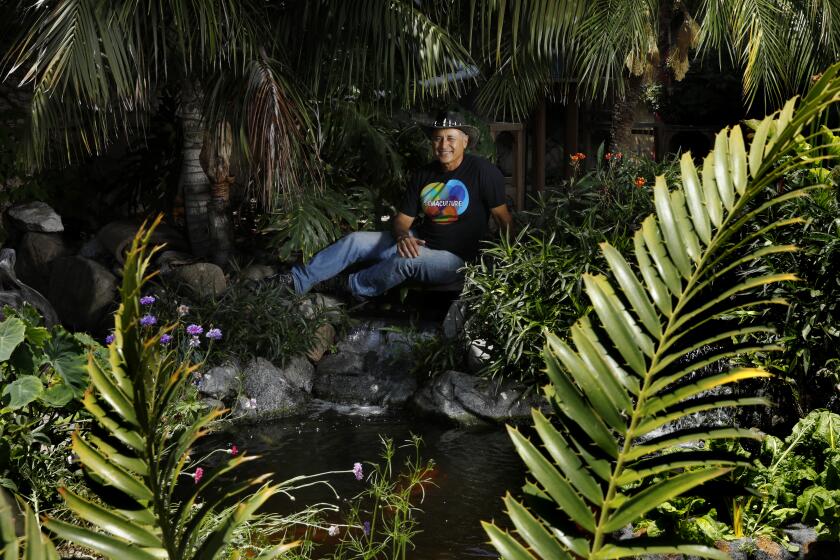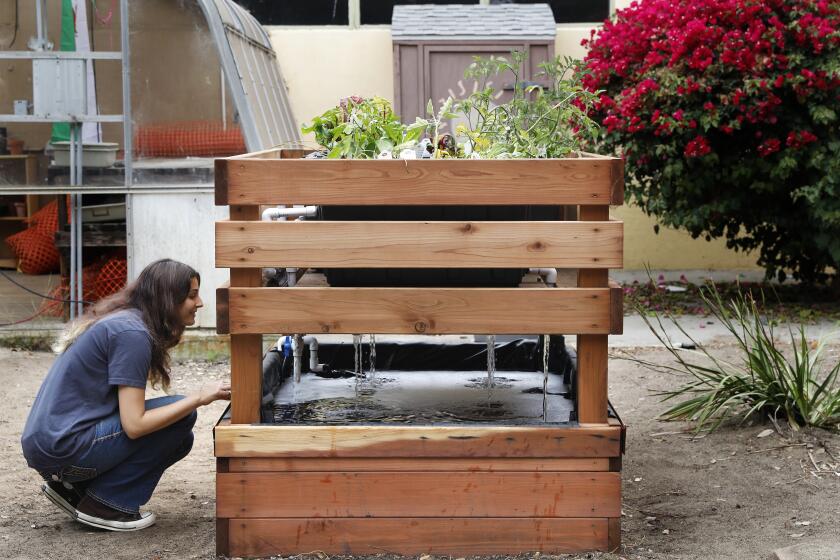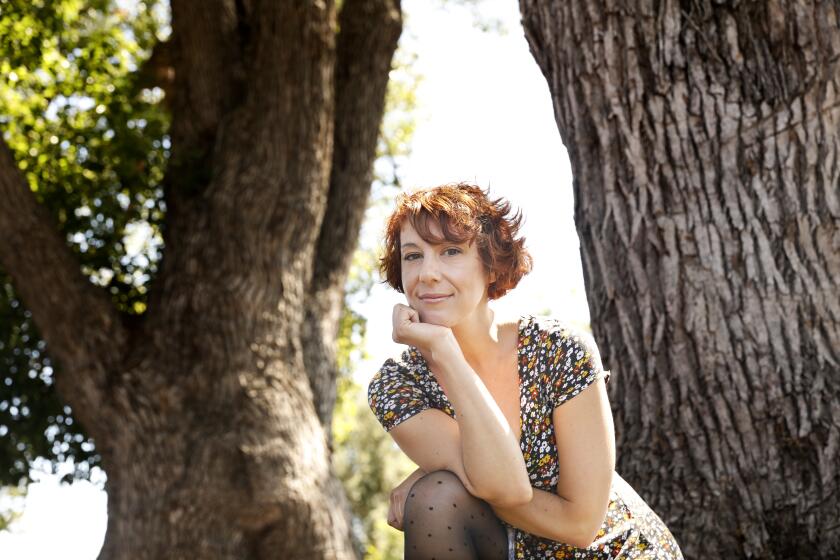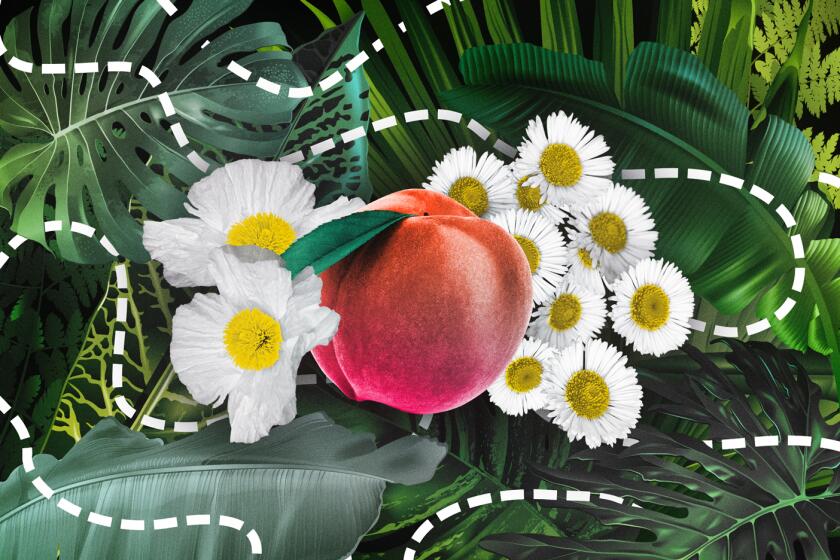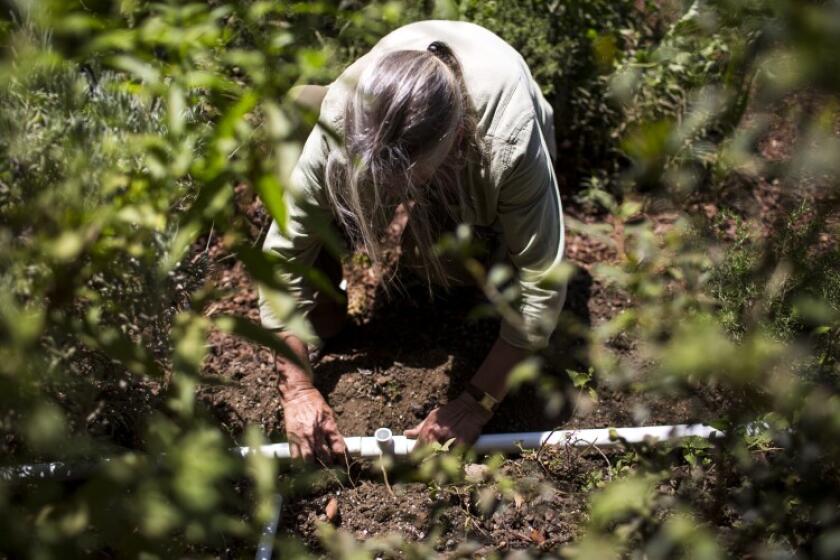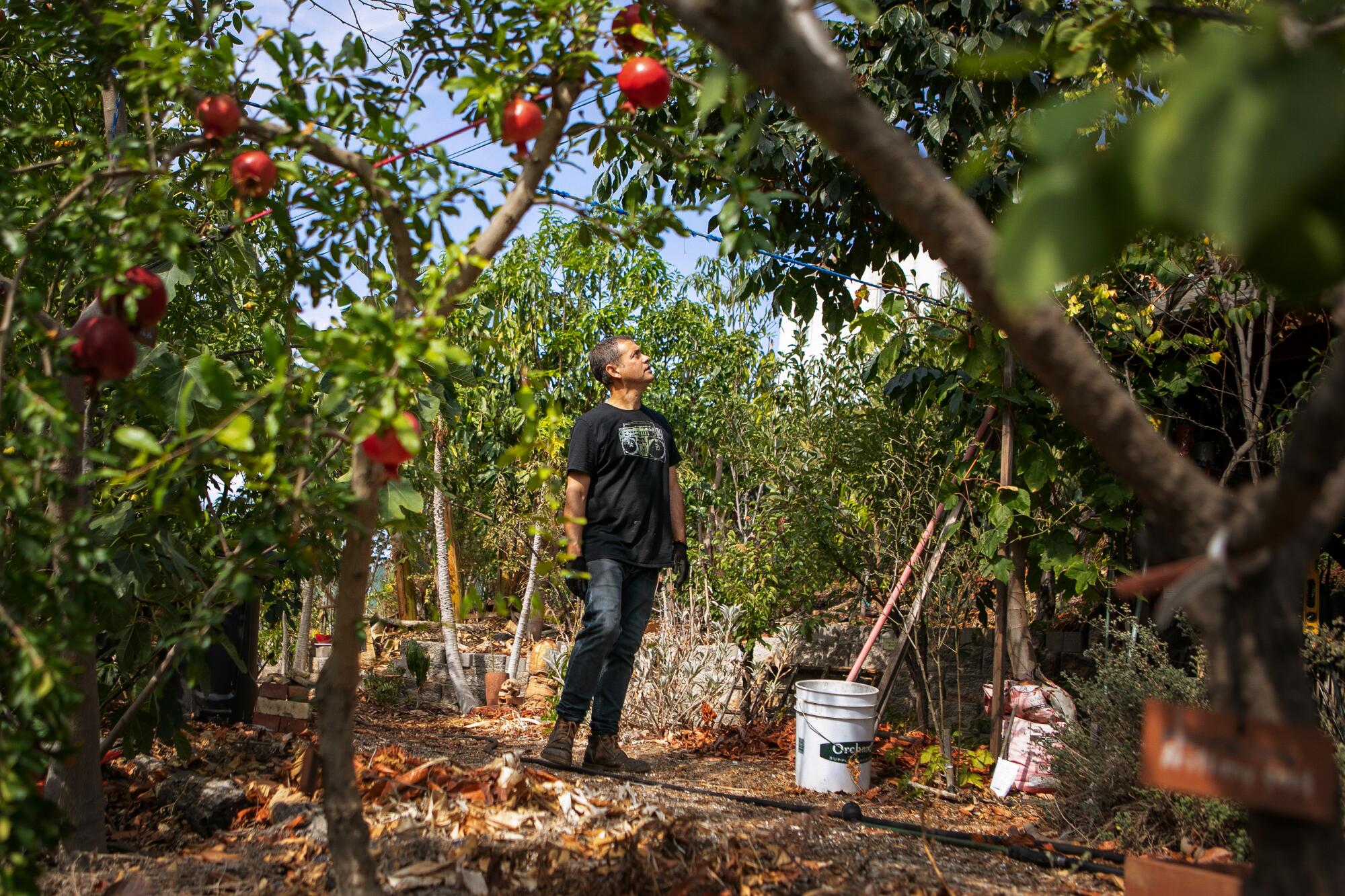
- Share via
Artist-teacher-gardener Jose Ramirez never considered a lawn for his Boyle Heights home. Instead, he created a smorgasbord landscape of fruit.
This is no ordinary orchard, with trees carefully spaced in neat rows. In a densely built residential neighborhood, he’s crowded more than 250 fruit trees along winding paths; multiple varieties of pluots, apricots, nectarines, apples, citrus and avocados are planted so close that their branches intertwine. Just a few steps out his back door, Ramirez and his family can pick fruit from 10 trees around a small deck — Bearss lime, papaya, cherimoya, mango, apple, guava, Meyer lemon, mandarin, nectarine and ... cinnamon?
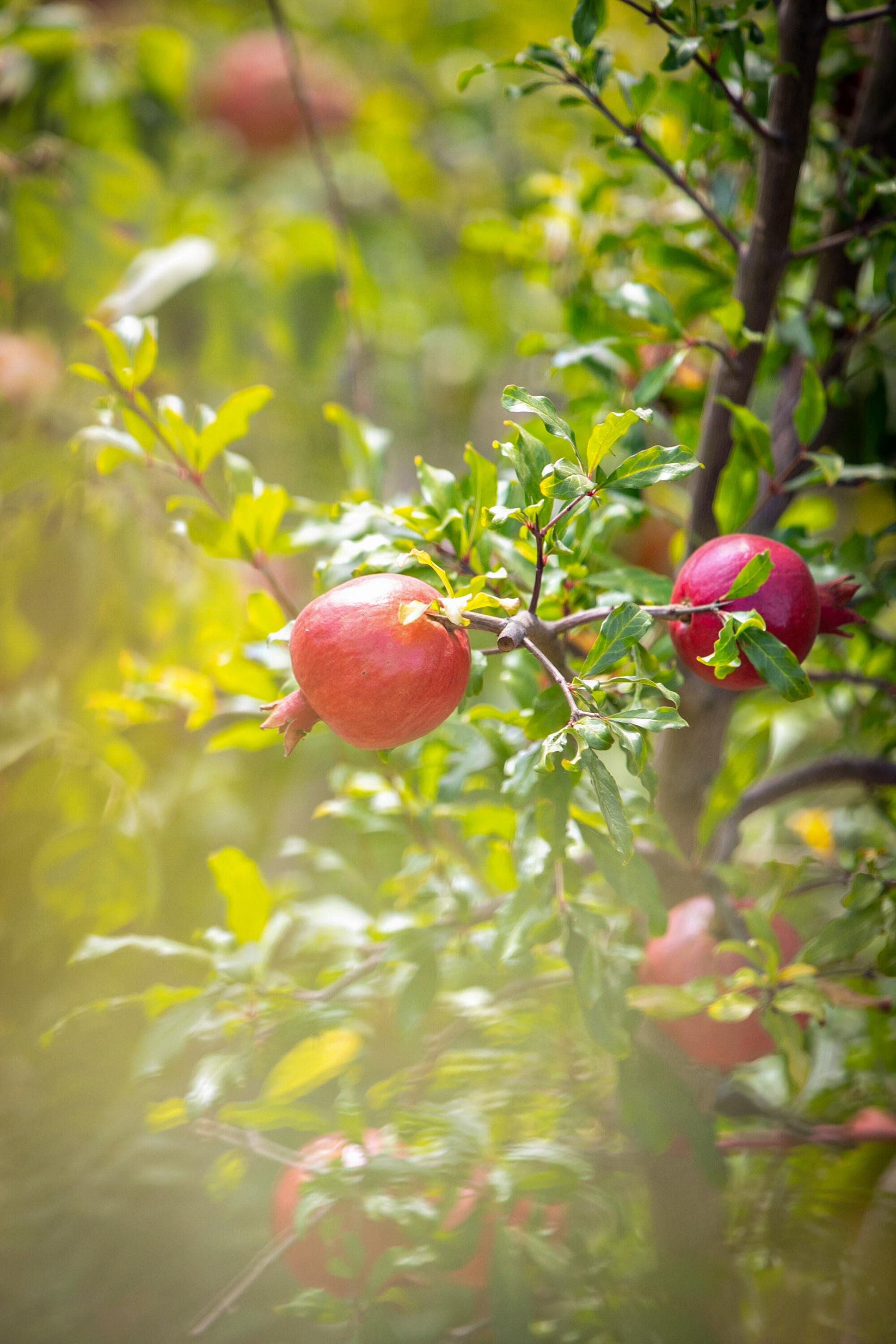
“You use the bark, and I haven’t taken much from that one yet,” Ramirez said, a little apologetically. “It’s still young and kind of an experiment.”
Which pretty much sums up his entire orchard, a lush experiment with organically grown fruit trees stretching out behind the home he purchased in 2002 and into a narrow adjoining vacant lot he bought in 2012.
Ramirez loves to experiment with unusual varieties too. He has coffee beans growing on one tree — he snacks on them occasionally for a seedy but sweet pick-me-up. Nearby, the long prickly arms of his dragon fruit are draped over the branches of other trees, preparing to flower. He has mature mango trees he grew from seed and at least eight different pomegranate trees, all heavy with fruit, despite the limited water they’ve gotten this year.

A Jamaican strawberry tree produces pinkish red berries year round that look like cherries but taste like — you guessed it — sweet ripe strawberries. And nearby is an astounding jabuticaba (Plinia cauliflora), a Brazilian tree whose plum-size glossy purple fruit grow directly off the tree trunk and branches instead of stems.
When he started, Ramirez had almost no experience with growing trees. Most of his learning was from watching YouTube videos (John Kohler’s Growing Your Greens is a particular favorite) and reading books about permaculture and composting. But being inexperienced was also a little freeing. He learned a lot by trial and error and didn’t let mistakes defeat him.
Replacing lawns with drought-tolerant plants is a good start in dry Southern California. Setting up a recycled water system is even better.
“Being an artist has helped me be a better teacher and gardener because being an artist means being creative and thinking outside the box,” he said. “I had a huge backyard with a lot of potential, and I started to go online looking at what nurseries had available. I’d see these exotic tropical trees, and I’d think, ‘I’ve got to try this.’ You know some things are going to work and some aren’t going to work, but you’ve got to take chances and try new things.”
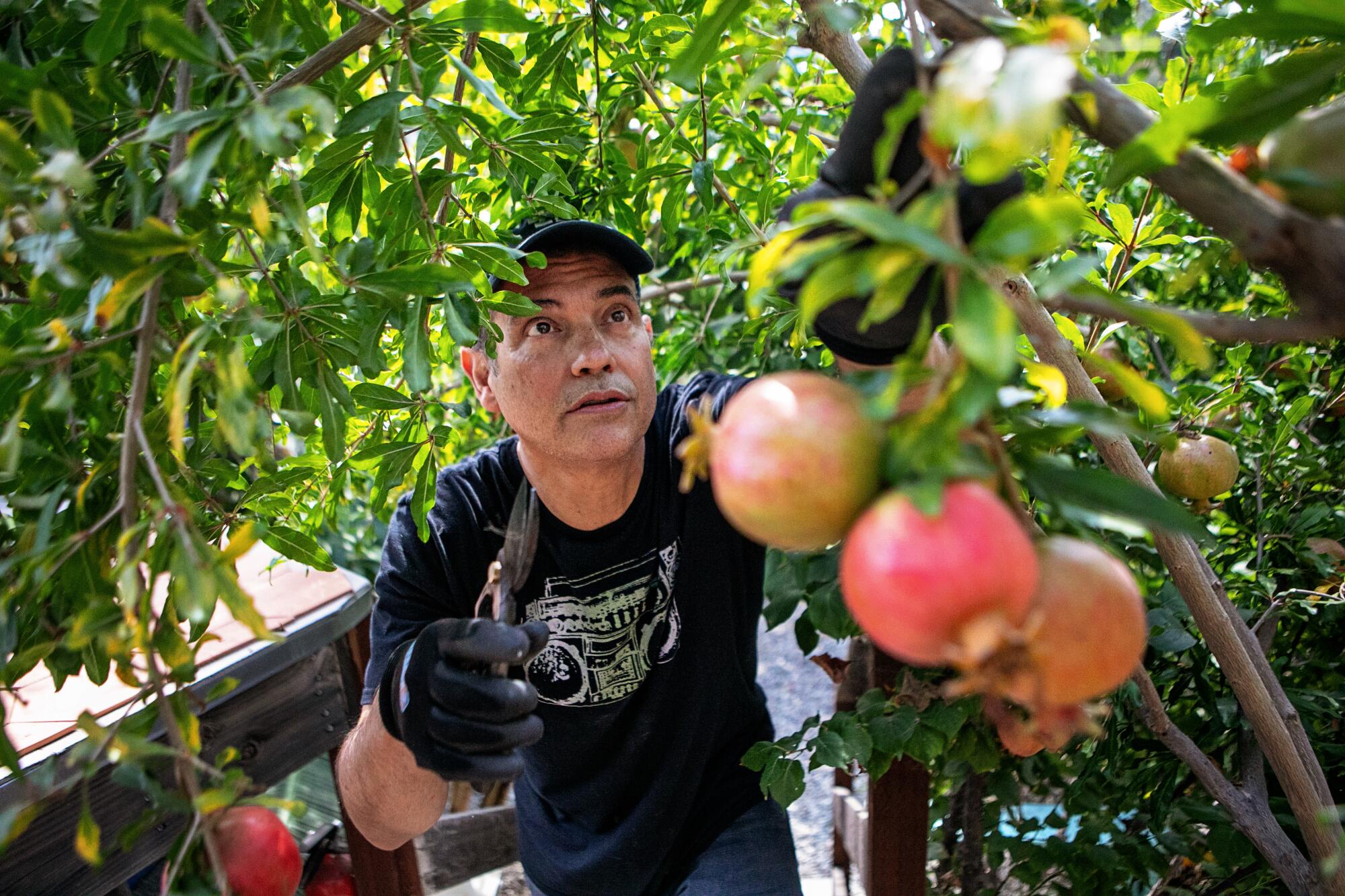
And there were plenty of failures, especially in the beginning. He remembered a family friend’s avocado tree when he was growing up —”It was always impressive to see” — and longed to grow his own, but the first avocados he planted all died. It took a few years before any survived, but he persisted, and now he’s got 10 varieties thriving in his yard.
“I’ve learned that avocados are very sensitive at the beginning, when you put them in the ground,” he said. “They don’t want to be overwatered or underwatered, so I had to pamper them in the beginning, with worm castings, compost tea and deep watering, and they finally caught on. Oh, and you can’t plant them in the heat of summer. Wait for fall or winter or very early spring, when the soil is moist.”
Most of the trees in his urban orchard are 10 to 15 years old, so they need only infrequent deep watering and thick mulch to help keep the moisture in the soil. He has a drip irrigation system but uses it only on the upper orchard where he’s planted young trees and tomatoes.
For his older trees, he uses gray water from his kitchen sink, and a rickety system of PVC pipes propped up on bricks to collect rainwater off his roof. Those pipes are dusty these days because of the drought, but when it rains, instead of running down his nearly vertical driveway into the street, all that free water gushes down the gutters around his roof and into the orchard soil, made spongey and friable by years of compost and mulch.
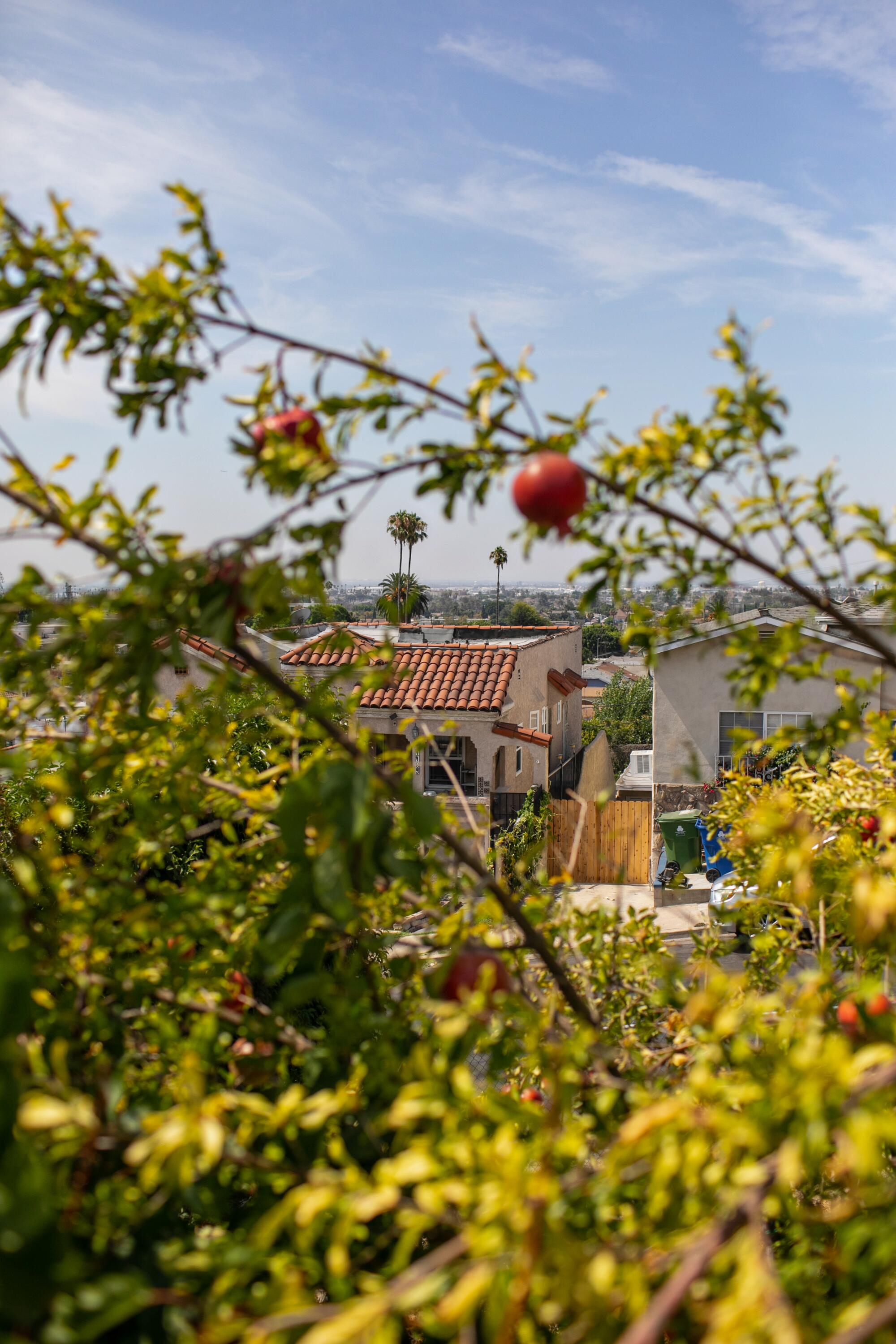
He doesn’t have to do that much in the orchard these days, but in the beginning, the work was intense. When he bought his fixer-upper house, he was recently divorced with shared custody of two young daughters and his focus was on updating the inside. But around the end of 2003, spurred by a commission to create a tile mural at Adventist Health White Memorial medical center in Boyle Heights, Ramirez began digging out the dirt beneath his hillside house to create a large studio where he could make his art. Load by load, he moved a small mountain of soil by wheelbarrow into his steep backyard, trying to create flatter places for planting.
When he was ready to start planting, the backyard was mostly dirt and weeds, he said. He removed most of the shrubs and nonfruiting trees — including a towering line of old ficus trees that worked as a hedge between his yard and the vacant lot next door. He kept their thick gray trunks, which act as a kind of sculptural retaining wall today, as well as a pomegranate, zapote, fig and olive trees.
As the drought continues, Californians are tearing out their lawns. Here’s a DIY guide to killing grass to prep for a drought-tolerant landscape.
Later, he used lasagna mulching to smother persistent ivy with layers of wet cardboard and a mulch of wood chips, sawdust and coffee grounds from a local cafe, as well as rock dust to re-mineralize the soil. And every day after work at Esperanza Elementary School in Pico Union, he’d stop at a hardware store and buy 10 more concrete bricks to build one of his many retaining walls.
“The landscaping part was kind of crazy,” he said. “I was bringing in materials every day and working until the sun went down.”
That he was gardening in an almost vertical space didn’t make the job easier. Buying a load of mulch was impossible, he said, because the trucks couldn’t get to his backyard, and there wasn’t room for a load to sit on his driveway or street, so he instead made frequent visits to a now-closed drop site where arborists could leave their wood chips for community use and bagged up as many chips as his small pickup could carry.
He did all this on top of teaching and making art, but Ramirez had lots of inspiration from his late father, who built and tended a terraced orchard and garden in his hilly backyard in El Sereno.
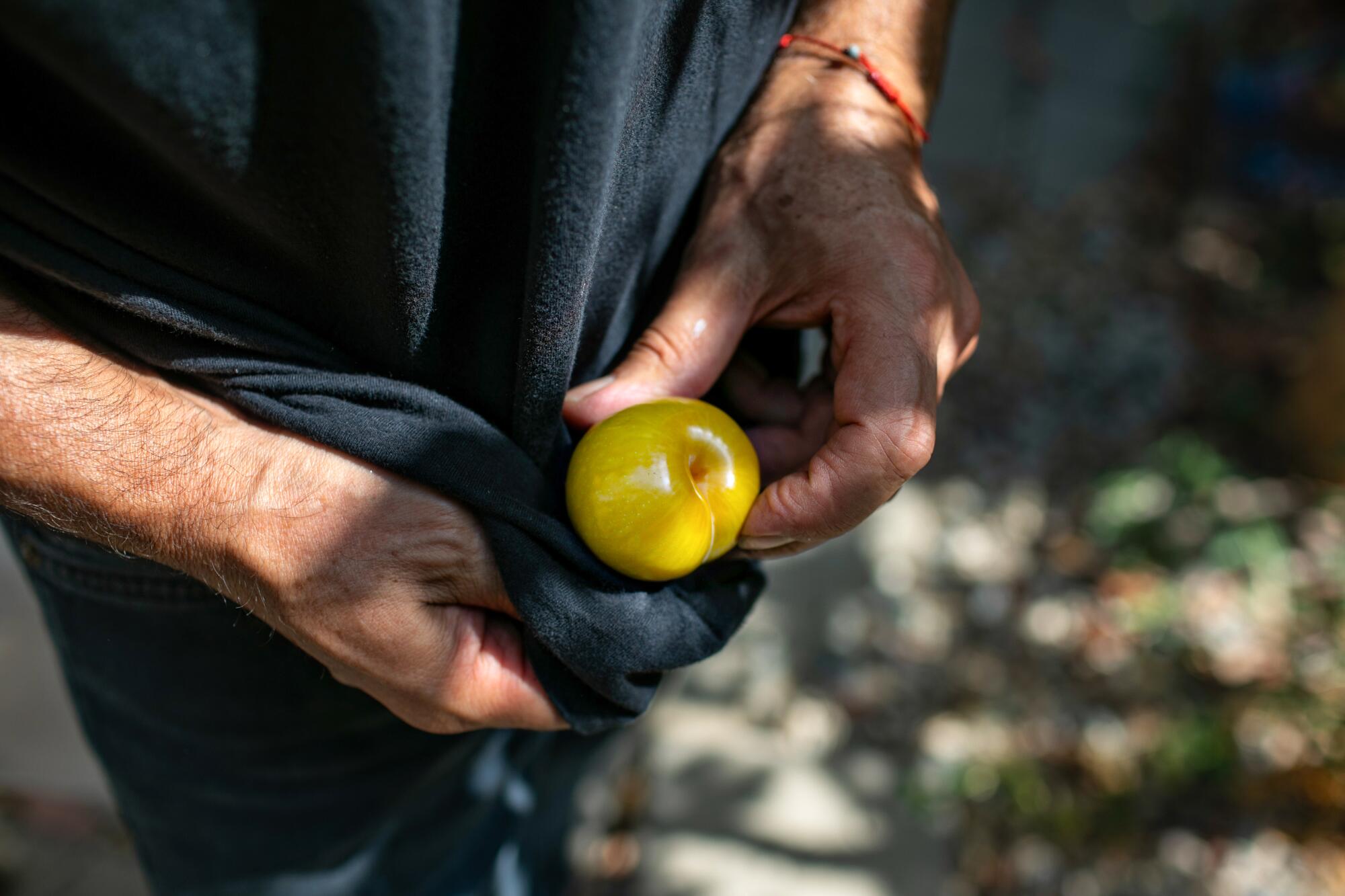
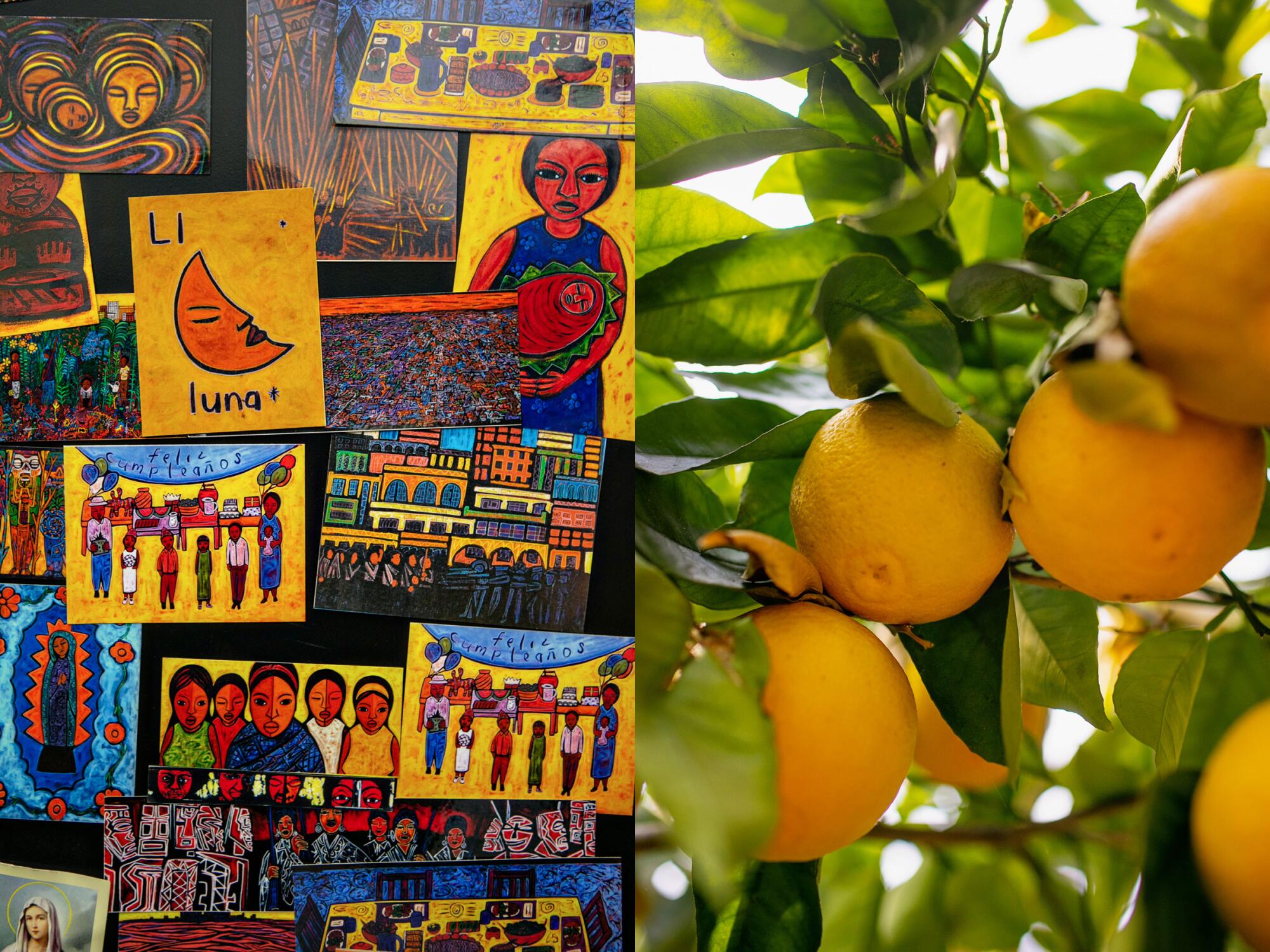
Jose Ramirez Sr. emigrated from Mexico to Los Angeles when he was about 10 and later served in the U.S. Navy. He started working as a carpet layer, Ramirez said, but ultimately supervised asbestos removal projects for the Los Angeles Unified School District.
When his day job was through, Ramirez’s father built stairs and terraces of planting boxes in his yard and planted vegetables, nopal cactus (which Ramirez’s mother, Maria, canned), grapes and fruit trees spaced far apart.
“He grew passion fruit and pineapple guava and cherimoya, and he was always looking for seeds people brought in from Mexico, especially chiles,” Ramirez said of his father. “His philosophy was, ‘If you’re going to plant something, plant something that will give you some food.’”
It took several years for Ramirez to appreciate his father’s passion for plants. As a child, he was fascinated by the garden, “but when I got older, I didn’t want to weed anymore,” he said laughing. “We had a big hill that had to be weeded, and hay fever was my excuse.”
Ramirez did pick up some gardening basics from his dad, but when it was time to start planting his yard, he went his own way, focusing mostly on fruit trees and planting them as close together as he could manage using organic permaculture techniques.
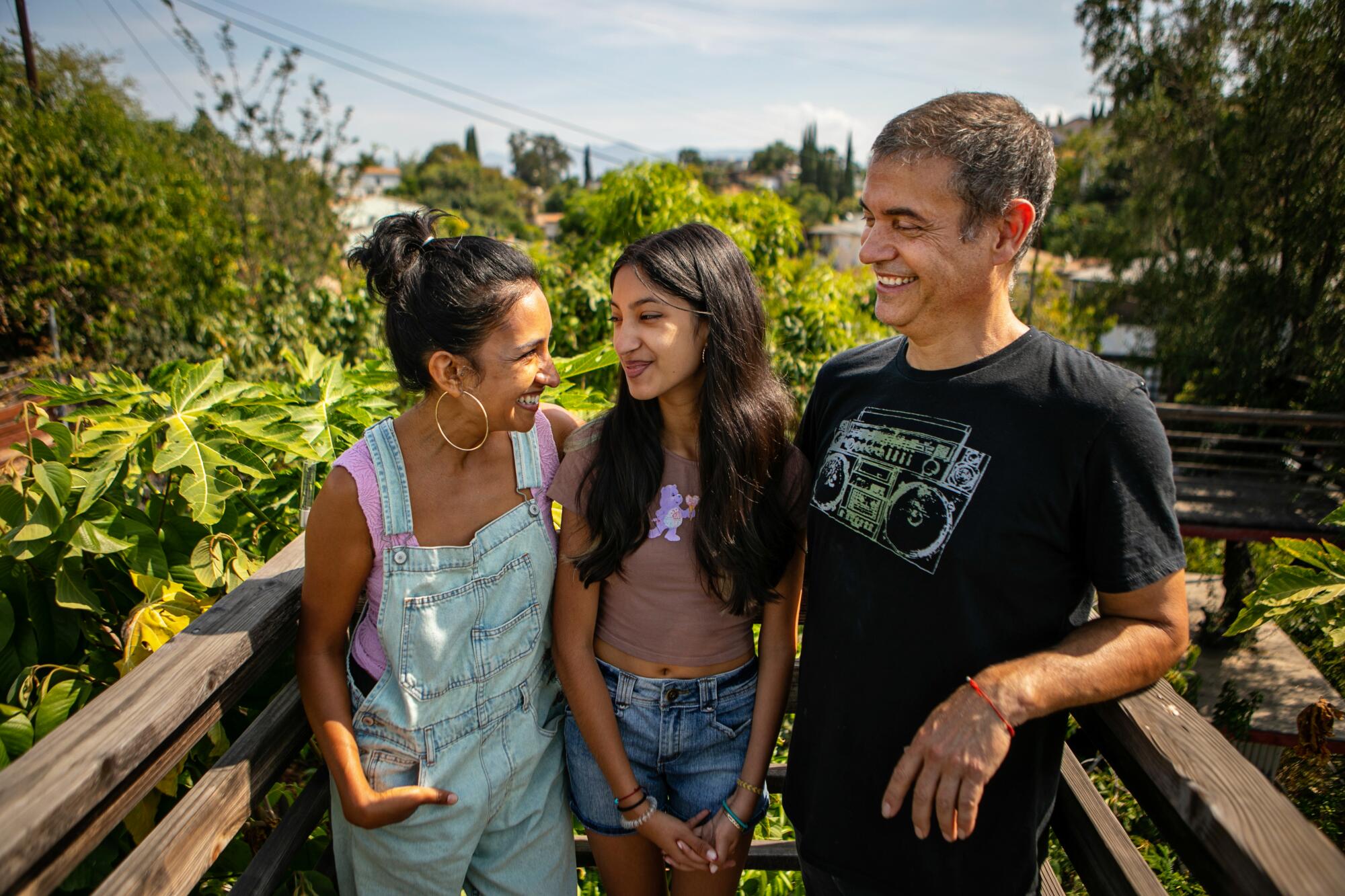
He remarried, and his wife, Sara Aguilar, a documentary filmmaker and dancer, remembers doing a lot of watering in the early days and worrying that the trees were going to die. She never needed a lawn, she said. In fact, her parents were members of the Theodore Payne Foundation and early advocates of Southern California landscapes that relied on native plants and food instead of turf. But she still had misgivings about her husband’s planting techniques.
“I thought he was crazy for planting so many trees so close together,” she said. “I was like, ‘There’s no way this is going to work.’ But slowly, I began to see his vision. I thought, ‘OK, I can see what’s happening,’ and it’s been really fun seeing the trees grow.”
A high school student created a small-space solution to growing food with recycled water.
Their daughter, Sol Aguilar Ramirez, 16, loves to wander in the orchard with her friends, picking fruit for immediate consumption. “They think it’s cool,” she said. “And it’s kind of peaceful to just sit.”
Ramirez’s schedule is gentler these days, but no less demanding. He’s just completed illustrations on his eighth children’s book — “My Dad Is a Fieldworker” (“Mi papá es un agrícola”) due to be published later this year. After nearly three decades as a classroom teacher, he considered retiring this fall to put more focus on his art, but his principal made him a counter offer too intriguing to refuse: Come back as the school’s art specialist.

Even in his new role, he expects to follow his same routine — getting to school around 6:30 a.m. to plan his lessons for the day and leaving around 2:30 p.m. “First, I come home and nap,” he said laughing. “Then I go check things in the garden. I have someone helping me now, so we go over pruning or fixing the drip irrigation or harvesting. And when it gets dark, I can focus on my art.”
Trees and other plants feature prominently in his art. He made ceramic name tags for every tree, listing their common and Latin names so he can learn their names as he’s working in the orchard. And beneath many trees are the ceramic vehicles, pyramids, masks and other relics he created for his MFA from UC Berkeley. The topic was serious — depicting the way Mexico’s artifacts were taken from historic sites by museums and other collectors — but under the trees, the effect feels almost whimsical, serene ceramic faces enjoying the shade.
The orchard was a godsend during the COVID-19 pandemic, he said. It became a refuge for friends and family desperate to find a safe place to gather. They would perch on the deck or around the trees, sharing meals and conversation along with the fruit. Pre-pandemic, he and Sara hosted open houses where people could tour his studio gallery and the orchard; he hopes to resume those later this year. People interested in a tour can leave their email address on his website for news about upcoming dates.
Photos on the Trees of L.A. Instagram account highlight the often-overlooked city trees that deserve attention from Angelenos.
Ramirez used to take boxes of fruit to school to share with his students and their families, but that stopped during the pandemic, when so many students learned from home. He and his family are vegetarians, so they eat a lot of what they grow. He passes out excess fruit to neighbors and family and donates boxes to community food banks.
The experiments continue in his orchard-yard. In an empty sunny section on the upper lot, he’s trying to build up the soil by creating compost piles directly in the ground. He dug a hole about 3 feet in diameter, which the family is filling with kitchen scraps and other green waste. He covers the hole with a board; when it’s full, he’ll make another, eventually creating a fertile area for more planting.
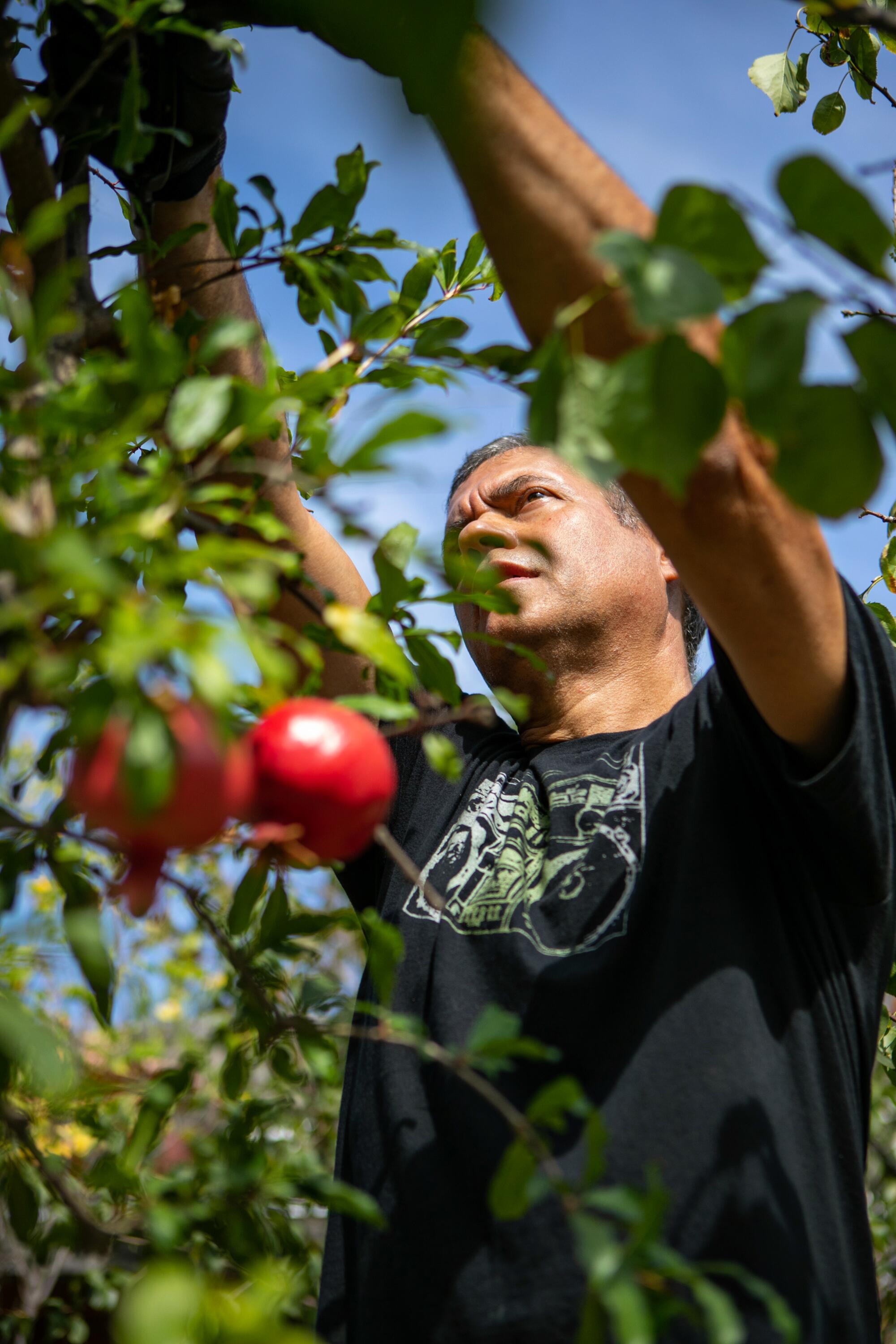
He’s also had to remove about a dozen stone fruit trees this year because of damage from a beetle known as the peach tree borer. Apricots and other stone fruits are among his favorites, so he’ll definitely replant when the weather is cooler and — one hopes — the ground has been refreshed by rain. He’s searching for replacement trees more resistant to the beetles, but he’s philosophical about the loss.
“The garden is always changing and growing,” he wrote in a text. “It’s life and death in action.”
Finding your favorite nursery can be thrilling. Here are our picks for the best independently owned plant nurseries near Los Angeles.
Tips for creating your own backyard orchard
- Research is crucial. Ramirez is a fan of experimentation, but he also believes in education. He spends a lot of time listening to gardening videos on YouTube, talking with experts at local nurseries or reading information on specialty websites such as Dave Wilson Nursery, Kuffel Creek Nursery and California Rare Fruit Growers.
- Plant when it’s cool, preferably in the winter or early spring, to give trees a chance to get established before the weather turns hot.
- Add a thick layer of mulch, such as 5 to 6 inches of leaves or wood chips to help keep moisture in the soil. Don’t get rid of the leaves or prunings from your trees. Use them for mulch, but place them several inches away from tree trunks to discourage disease and insect infestations.
- Improve your soil. Ramirez believes in growing organically and using organic amendments such as compost and worm castings to encourage the growth of beneficial microbes and mycorrhizal fungi in the soil, which help trees and other plants better absorb nutrients and water. To that end, he recommends buying good quality organic compost, such as Bu’s Blend by Malibu Compost, or making your own.
- Add rock dust or azomite minerals to your soil to improve water retention as well. “I get a 50-pound bag of rock dust and just broadcast it around the orchard or add a handful around the circumference of the trees,” he said.
- Use compost tea to feed your trees while watering. Ramirez has had good luck with a dried compost tea from Boogie Brew, a company in Sonoma County that has been helpful in answering questions as well.
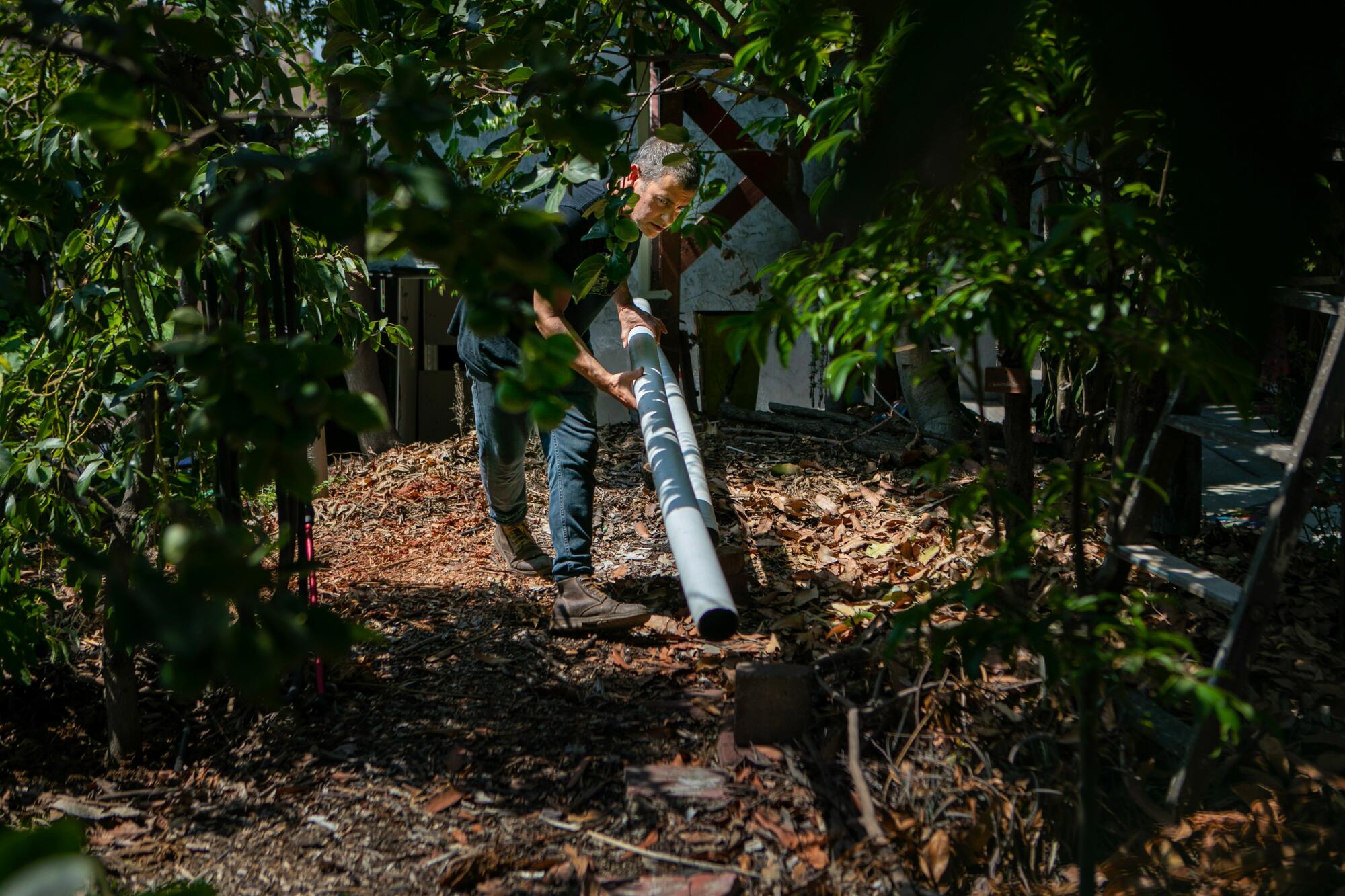
- Filter your irrigation water to remove chlorine and other chemicals that can destroy the beneficial microbes you want to encourage in your soil. Ramirez uses a Boogie Blue Filter Plus that just screws onto his hose, which is also made by Boogie Brew.
- Be open to experimentation. If you’re interested in a fruit that normally grows in other locations, read all your can about it, consult with the nurseries that grow those trees and then give it a try, Ramirez said.
- Don’t give up. Failure is a given in gardening, Ramirez said. Learn from your mistakes and keep trying.
The water that cleans your clothes isn’t safe to drink, but it could be good for your plants. Here’s how to use grey water amid drought restrictions.
More to Read
Sign up for The Wild
We’ll help you find the best places to hike, bike and run, as well as the perfect silent spots for meditation and yoga.
You may occasionally receive promotional content from the Los Angeles Times.
